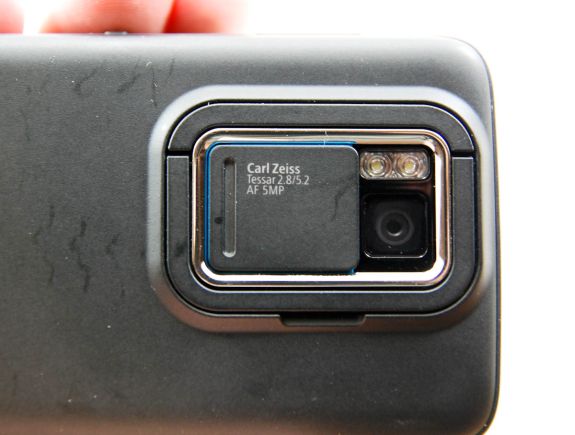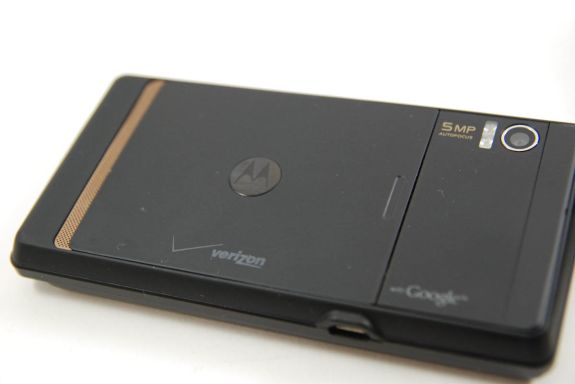Two OMAP 3430 Phones: Nokia N900 and Motorola Droid
by Brian Klug on June 10, 2010 9:29 PM EST- Posted in
- Smartphones
- N900
- Maemo
- Motorola Droid
- Droid
- MeeGo
- Android
- Mobile
N900 Camera
I've already talked briefly about the N900's camera, which is true to form for Nokia devices and pretty impressive. The software implementation that Nokia has put together for the N900 on Maemo is well polished. As mentioned before, sliding the camera cover open while the device is on immediately launches the camera application, or you can get there from the applications window. After launching, there are black bars at each side, the right side of which is used for settings icons. Nokia has included a ton of options here, including optional geotagging, settings for exposure, ISO, and preset shooting modes. You can capture in 3.5 megapixel or 5 megapixel modes, and have ISO 100, 200, 400 or automatic to choose from. In auto mode, it seems like the camera can go all the way to ISO 800 if necessary, but you can't set that manually. True to the rest of Maemo, the camera only works in landscape orientation.
What's really impressive is just how sharp and fluid the N900 camera preview looks while you're shooting. Suffice it to say, only the HTC Incredible really rivals how sharp and detailed the images look in the live preview. Framerate is always solid, and I just left the settings on defaults because I was pleased with the quality. The hardware button itself is two-position. Pushing halfway down triggers autofocus, pressing all the way takes the shot. One of the nice things is that if you jam the shutter button all the way down, it really takes the picture immediately; there's no mandatory AF run before actually capturing. This is potentially really handy if you're trying to capture something quick action and you're already confident it's in focus.
The N900 can capture videos at up to 848x480 at 25 fps in MPEG-4 format with AAC audio. That's an aspect ratio of 16:9 interestingly enough. I was a bit concerned initially about video being shot at 25 fps, but this is becoming more and more the case with 720P class smartphone video. Quality itself is very good as we'll see in a second.
Motorola Droid Camera
The Motorola Droid packs a slightly more standard 5 megapixel camera, also with autofocus and dual LED flash. While it doesn't carry fancy Carl Zeiss branding or advertise what kind of optical lens system drives it, it's likely the same or a very similar OmniVision camera sensor at the core. The Motorola Droid also supports video recording, though at slightly lower 720x480 resolution at slightly higher 30 fps. Video is encoded in H.264 and audio is AAC.
The camera application for the Motorola Droid is also stock Android 2.x. Love it or hate it, the application is essentially uniform across the platform with the exception of HTC's custom camera application like on the HTC Incredible. You've got settings for most of the basic things, but just not as much as you do on the N900 - though both of these have many more settings than iPhone OS which always handles everything with no chance for user override.
The camera can be launched either from the applications menu, or by pressing the dedicated camera button all the way down while the device is on. Motorola talked a fair amount about the copper colored camera button which - I guess - is a feature. Unfortunately, I did encounter a considerable amount of bugginess with the Droid's camera. Launch would periodically take a very long time (well over 8 seconds), in which case you'll probably just give up and move along, and I noticed a very strange quirk where switching from landscape to portrait (eg shutting the keyboard drawer) would result in camera UI elements being drawn in the wrong place. A few times, the frame around the camera preview would just render inside atop the image, which is very frustrating. Killing and relaunching fixes that, though.












68 Comments
View All Comments
Wadzii22 - Friday, June 11, 2010 - link
Out of curiosity I ran linpack and Benchmark pi on my droid that's oc'd to 1ghzmy benchmark pi score was 1280 and linpack gives me 17.24 mflops
strikeback03 - Friday, June 11, 2010 - link
Did you run them stock? As those numbers seem to be a ~4x improvement over what is shown here, which seems odd given the ~2x increase in clockspeed.Wadzii22 - Wednesday, June 16, 2010 - link
with the phone completely stock my scores were basically the same as whats in the original article.jamyryals - Friday, June 11, 2010 - link
Please continue this type of in depth comparison with current and future hardware. PC hardware is all well and good, but it's all so fast now the mobile space is a much more interesting battle. Not to mention with how fast things are evolving there is the opportunity for a lot of content.Ratman6161 - Friday, June 11, 2010 - link
For eample, my droid purchased in early April came out of the box running at 600 MHz (though now it actually runs at up to 900 Mhz). My wife got hers in early June and hers is 600 MHz too and also came out of the box with Android 2.1 already on it.Wadzii22 - Friday, June 11, 2010 - link
For whatever reason, setcpu always sees a stock droid's max at 600, but they do run at 550. I just got a new one yesterday after bricking my old droid, it showed the same thing.CharonPDX - Friday, June 11, 2010 - link
Nokia was the originator of the "sell unsubsidized smartphones direct" model, years before Apple or Google. You could get a Nokia N80 at CompUSA completely unlocked for $800 in 2006, a year before the unsubsidized iPhone.Stas - Friday, June 11, 2010 - link
0.1 build with fixed WiFi and maps.LinPack - 12.2 (twelve point two)MFLOPS
Engadget.com loads in 20 sec (default browser)
'nuff said.
Stas - Friday, June 11, 2010 - link
forgot to mention. the CPU is at 800Mhz. I've had it up at 900Mhz with bare Android build (leaked 2.2) and the performance seems no different, but no numbers, sorry.milli - Saturday, June 12, 2010 - link
That's pretty wrong what you're saying there.Qualcomm didn't even license the A8 (nor will they ever).
What they did license is the ARMv7 instruction set (and that's a huge difference). With that they made a custom implementation of the ARMv7 architecture. (BTW Qualcomm already stated in 2005 that they're an architectural licensee for ARM’s ARMv7 instruction set)
There are many differences between Scorpion and A8.
I'll quote from a certain article since i can't say it better:
'Although Scorpion and Cortex-A8 have many similarities, based on the information released by Qualcomm, the two cores differ in a number of interesting ways. For example, while the Scorpion and Cortex-A8 NEON implementations execute the same SIMD-style instructions, Scorpion’s implementation can process128 bits of data in parallel, compared to 64 bits on Cortex-A8. Half of Scorpion’s SIMD data path can be shut down to conserve power. Scorpion’s pipeline is deeper: It has a 13-stage load/store pipeline and two integer pipelines—one of which is 10 stages and can perform simple arithmetic operations (such as adds and subtracts) while the other is 12 stages and can perform both simple and more complex arithmetic, like MACs. Scorpion also has a 23-stage floating-point/SIMD pipeline, and unlike on Cortex-A8, VFPv3 operations are pipelined. Scorpion uses a number of other microarchitectural tweaks that are intended to either boost speed or reduce power consumption. (Scorpion’s architects previously designed low-power, high-performance processors for IBM.) The core supports multiple clock and voltage domains to enable additional power savings."
"Qualcomm claims that Scorpion will have power consumption of roughly 200 mW at 600 MHz (this figure includes leakage current, though its contribution is typically minimal in low-power processes). In comparison, ARM reports on its website that a Cortex-A8 in a 65 nm LP process consumes .59 mW/MHz (excluding leakage), which translates into about 350 mW at 600 MHz."
With that said, i don't understand where the misconception about the Scorpion being an A8 started. Even Qualcomm states clearly on their own website that Scorpion is not licensed from ARM. They also state that they invested hundred of millions in creating their own core based on the ARMv7 instruction set.
I hope now all the staff from Anand will stop saying that there's an A8 inside of Snapdragon. Or maybe you should even clarify that with a small article.